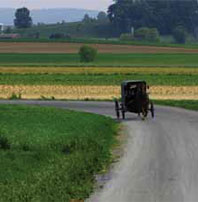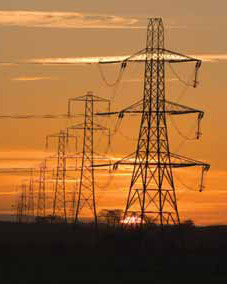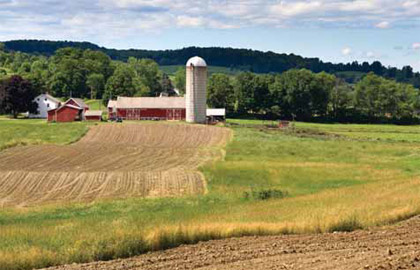Eminent Domain and the Violation of Rural America Part One
A Rural Heart
Judy Almquist is a retired farmer and widow on a fixed income. The treasured memories of her life with her husband and their children are as much a part of the landscape of her heart as their rural Virginia farmland she still calls home. As she turns closer to 70, she thinks more and more about the importance of this legacy. “I’ve only got 50 acres here. But it’s what I have; it’s all I have,” Judy said emotionally. Despite the size or the sale value, Judy still confidently says, “this is my land.”
This landscape, though, a tract she plans to leave to her children, will change if Allegheny Energy and Dominion Virginia Power have their way. Their proposed 500-kV Trans-Allegheny Interstate Line (TrAIL) will extend from Southwestern Pennsylvania (37 miles) to West Virginia (114) to Northern Virginia (28 miles) clear-cutting more than 7000 acres of coveted, forested land through state and federal conservation easements, historical lands, a National Forest, state parks, protected watersheds, wildlife reserves and thousands of landowners’ homes. Allegheny Energy says this high voltage interstate power line is “necessary to meet the growing demand for power in the Mid-Atlantic region.”
According to more than 90% of West Virginia residents who have sent letters to the West Virginia Public Service Commission, they do not agree. The same sentiment is being played out by residents in Pennsylvania, Virginia, New York and every other state within the U.S. that is currently in threat of being compromised by Congress’ latest misstep known as the “National Interest Electric Transmission Corridors” (NIETC).
When asked about her reaction to these proposed Corridors, Almquist, in a voice full of passion and fervor, was not at a loss for words. “It’s not fair. It’s not American!” Government seizing residential land via eminent domain never has been a well-received act, but to do so to benefit for profit self-serving electric companies is definitely not within the core tenants of a democratic society, especially those of the United States of America. This behavior might be excusable if there were no alternative to feeding America’s growing energy addiction, but there is – and all these alternatives are healthier, greener, cleaner and more cost-effective.

© iStockphoto.com/texasmary
The NIETC
What’s really at issue here is the Department of Energy’s (DOE) draft designation of the NIETC, legislatively mandated as a result of Congress’ Energy Policy Act of 2005 (EPACT 2005). Congressmen Frank Wolf and Maurice Hinchey have been working feverishly to get Congressional support to rescind Section 1221 of EPACT 2005 which provides for these Corridors. According to a June 12, 2007 positioning statement by Wolf and Hinchey, these designations are “… ‘Coming Soon to a Neighborhood Near You.’ Today the draft designations affect 11 states but the next series include all or parts of 29 more states.” Obviously, these designations will leave only 10 states untouched.
There is no doubt that the proposed Corridors incite much fury and they should, given their impact on hundreds of thousands, and possibly even millions, of American citizens throughout this nation. It’s an issue that involves businessattired politicos, plaid-wearing farmers and suburban families, and well-manicured electric company CEOs.
At the root of this critical controversy are three main issues: private land ownership, the environment and national security. The latter, ironically, is a federal door that swings both ways: DOE Secretary Samuel Bodman says the Corridors are necessary to ensure national security; however, high ranking Department of Defense (DoD) officials within the Pentagon maintain just the opposite. They say that the military will not participate in these Corridors not only because these proposed approximate 200 ft. high interconnected towers are a beacon for terrorist attacks on American soil, but also because “they are not sustainable.”
Over the past few years, the DoD seems to have quietly migrated into one of the most pro-environmental departments, if not the most pro-environmental department, within the U.S. federal government. While Secretary Bodman continues to support ages-old coal-fired, CO2 generating electricity, forward moving military services, such as the U.S. Air Force, are becoming the standard for green, clean and renewable energy generation, producing workable, non-polluting and cost-effective solutions to energy independence and national security.
A Historical Perspective: A Labyrinthine Policy
On April 26, 2007, the United States DOE, under regulations of Congress’ EPACT 2005, determined that energy consumers specifically in the Mid-Atlantic and Western regions of the United States were “adversely affected by transmission capacity constraints.”

© iStockphoto.com/mountainberryphoto
In a May 2007 Arlington, Virginia, public hearing, one of the few public hearings the DOE planned to hold on this critical issue, DOE representatives stated that they do not endorse nor condone any method proposed as a solution to alleviate these energy constraints. According to these representatives, the draft language and designation of these National Corridors is not a strict solution in and of itself; instead, these Corridors serve only to define the nature and scope of the problem while not enforcing nor proposing any specific solution.
Instead of proposing solutions, the DOE leaves problem-solving to the affected states, the Federal Energy Regulatory Commission (FERC) and to private industry – in particular, with respect to the Mid-Atlantic Corridor’s high transmission power lines, PJM Interconnections, Allegheny Energy and Dominion Virginia Power. The Public Service Commissions of each state (gubernatorial appointees) have only interim, state-level authority because Congress gave the final authority to the federal government – the Federal Energy Regulatory Commission.
Climate Change and National Security
When the DOE examined the “national interest” for increased energy demand, the organization said they never considered the means of energy production. In fact, these representatives said they focused on establishing areas of interest with the eventual goal of providing energy-addicted Americans, living in primarily densely populated areas, such as Washington, D.C. and New York City, with their “fix” for excessive energy use. The problem, then, exists in for profit electric companies, such as Allegheny Energy and Dominion Virginia Power, jumping on the National Corridor bandwagon, in some cases, almost a year before these draft designations were announced – before American citizens even knew this threat existed. Their solution is the proliferation and continued use of an archaic form of energy, manufactured via outdated coal fired power plants, known as “dirty coal” – the primary cause of human-induced greenhouse gases (GHG), which is the biggest contributor to global climate change.
These DOE spokespersons concurred with Bodman that the NIETC was needed as an issue of “national security.” But, again, a recently released report by three and four-star retired Generals and Admirals says differently. To them, global climate change is the most pressing national security threat. Therefore, supporting this type of antiquated, CO2 producing energy generation would actually be a national security threat, not a national security solution.
In fact, a further reliance on “dirty coal” for energy will only lead to an unstable future both in terms of climate and security. In May 2007, the Intergovernmental Panel on Climate Change (IPCC) released findings that call for the world to reduce carbon emissions and GHG by 2015. These “dirty coal” fired high transmission power lines, to be developed by Allegheny Energy and Dominion Virginia Power and to be operational in 2011, would have an effective life span of 30-50 years – an obvious, disastrous step backward in curtailing global climate change, creating an obvious, blatant and total disregard for the welfare of the world’s inhabitants.
Climate Change and Water Shortage
Global climate change and its myriad repercussions impact almost every aspect of human, plant and animal life. But one of the most detrimental results of global climate change will appear in a significant reduction of potable water, an obvious issue of survival.
Experts say that as sea levels continue to rise, coastal lands will be inundated with salt-water that will destroy the current, drinkable groundwater system. This devastation, however, would not be contained at the ocean’s coast. As water levels continue to change, the U.S. Geological Survey (USGS) projects that the salinity of salt water will encroach “on municipal water intakes from rivers.” This will lead to a lack of drinking water in many parts of America and the world – a complete devastation to mankind.
Eminent Domain and the Loss of States’ Rights: The Repercussions
Even if those states affected by the DOE’s draft National Corridor choose not to approve Allegheny Energy’s and Dominion Virginia Power’s “dirty coal” fired high transmission power lines, the EPACT 2005 legislation connected with these National Corridors places the final authority for such transmission line siting within the hands of the federal government not the state government.

© iStockphoto.com/moonmeister
This authority granted to the Federal Energy Regulatory Commission by Congress in EPACT 2005 is commonly referred to as the “Backstop Authority,” which allows energy companies like Allegheny Energy and Dominion Virginia Power to seek a federal appeal of a state’s denial of a transmission system.
This “Backstop Authority” is a new concept, never before used; however, if applied would undoubtedly guarantee excessive federal involvement in states’ rights, particularly with its power of eminent domain and its right to usurp the states’ transmission line siting authority, all for the benefit of for profit power companies. For the “Backstop Authority” to be used, a spokesperson for FERC stated that the transmission line in question must relate to a specific DOE national interest area and can be used if the state has either rejected or not acted on an energy company’s proposal within one year, which is why the draft designation of National Corridors is such a critical part of this controversy.
If any of the states in question, or FERC, approve the proposed siting, the energy companies will, in essence, have the power and authority of eminent domain, allowing them to condemn private property for their use and profit. This includes Judy’s property and hundreds of thousands of other farmers and rural land owners currently at risk. All of whom may have no recourse to save their property, their families or their livelihood.
The Nation’s Health
If eminent domain supersedes the rights of private land owners, America will suffer a devastating blow on its health as global warming continues, leading to adverse health conditions and worse.
In the immediate future, those who live near these high-voltage power lines will be at great risk. In fact, those with auto-immune disorders, pacemakers, metal heart stents and other implanted biomedical devices will be unable to live near such areas. This alone will effectively displace thousands of land owners from their own property, given the age and health conditions of the average farmer and rural land owner.
Recent reports from the United Kingdom have also linked childhood leukemia to close proximity of high voltage power lines. And the World Health Organization has classified high voltage transmission lines as a possible carcinogen. In addition, the California Department of Health Services has linked adult brain tumors, adult leukemia and miscarriages to similar, high voltage lines.
The Desecration of “America the Beautiful”
While health is of the utmost concern in regards to the proposed NIETC and these seemingly symbiotic high voltage power lines, America’s natural beauty is also under attack. The proposed transmission lines would cut across private property, public lands and protected state and federal conservation easements at a soaring, eye-sore height taller than the Statue of Liberty on Ellis Island.
The towers, approximately 200 feet above ground, are also slated to cut through Civil War battlefields, wildlife refuges, national parks and national forests – a non-green solution that would destroy the great, green grasslands and forests of America – an unspeakable tragedy for all Americans and also for the environment.
The Destruction of Rural America
Another issue of the proposed NIETC and these resultant transmission lines involves the loss of livelihood and legacy so strongly associated with land in rural America. Many potentially impacted farms and tracts of land have been family property for generations upon generations. For countless rural Americans, these National Corridor designations will destroy a way of life that has been the backbone of America since before becoming a nation.
In addition, it would destroy their livelihood and businesses as farmers may be less likely, and in many cases, unable (depending upon their proximity to these high voltage power lines) to raise the livestock and food needed to feed the nation.

© iStockphoto.com/cglade
As in aside, those farmers in rural areas currently in need of a power line transmission upgrade would be able to accomplish this via low transmission power lines powered by clean and green renewable energy, such as windmills. Low voltage power lines do not have the same devastating effects as high voltage power lines, allowing people to live closer to these lines without the same health implications.
And from a market perspective, high voltage lines will affect property values, creating economic devastation for tens of thousands of families. According to Judy Almquist, her property value will decrease by as much as 80% of its original valuation, according to her appraiser. This is a bitter pill for an American woman entering the twilight of her life, who raised a family and buried a husband, and who always believed in the sanctity of her basic American rights.
The Poster Child for America’s Failed Energy Policy
The NIETC and Section 1221 of EPACT 2005 serve as the antithesis of America’s failed energy policy. In early June, President Bush announced that the leading contributors to global warming, including the United States, will need to submit solutions to curtail global climate change by 2008. Many in government, however, continue to disproportionately support the use of antiquated, CO2 producing “dirty” coal powered electric generation rather than clean, green and renewable energy. At the same time, two of the easiest and least expensive energy solutions, demand management and education, are all but ignored.
According to recent reports in ScienceNOW, since January 2001 carbon emissions in America have increased by 10 percent. At the current rate, if the National Corridors designations are adopted, these numbers will continue to grow unchecked. This course of action will guarantee that the world’s climate change problems will not only continue, but significantly increase, putting America and the world at even greater risk.
If this continues, energy demand and generation are going to be the least of America’s problems.




























